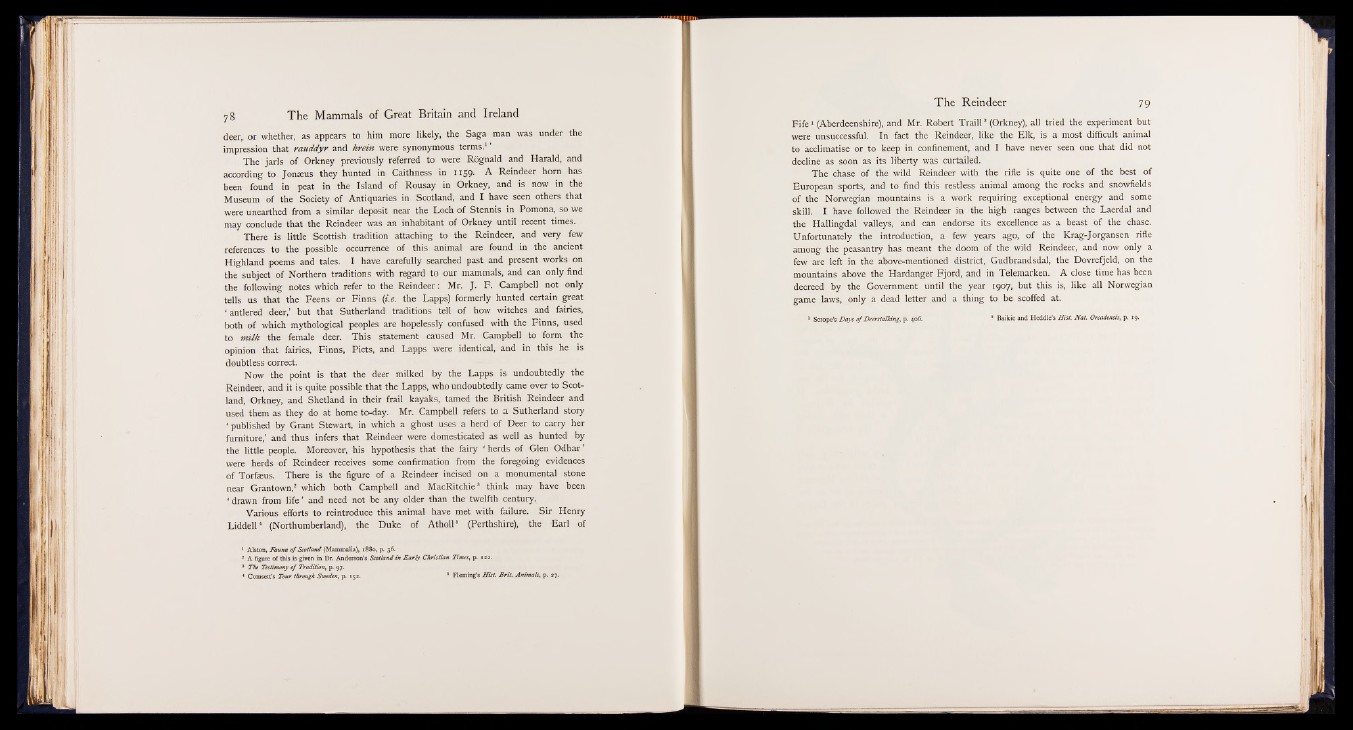
deer, or whether, as appears to him more likely, the Saga man was under the
impression that rauddyr and kretn were synonymous terms.1
The jarls of Orkney previously referred to were Rognald and Harald, and
according to Jonaeus they hunted in Caithness in 1159. A Reindeer horn has
been found in peat in the Island of Rousay in Orkney, and is now in the
Museum of the Society of Antiquaries in Scotland, and I have seen others that
were unearthed from a similar deposit near the Loch of Stennis in Pomona, so we
may conclude that the Reindeer was an inhabitant of Orkney until recent times.
There is little Scottish tradition attaching to the Reindeer, and very few
references to the possible occurrence of this animal are found in the ancient
Highland poems and tales. I have carefully searched past and present works on
the subject of Northern traditions with regard to our mammals, and can only find
the following notes which refer to the Reindeer: Mr. J. F. Campbell not only
tells us that the Feens or Finns {i.e. the Lapps) formerly hunted certain great
‘ antlered deer,’ but that Sutherland traditions tell of how witches and fairies,
both of which mythological peoples are hopelessly confused with the Finns, used
to milk the female deer. This statement caused Mr. Campbell to form the
opinion that fairies, Finns, Piets, and Lapps were identical, and in this he is
doubtless correct.
Now the point is that the deer milked by the Lapps is undoubtedly the
Reindeer, and it is quite possible that the Lapps, who undoubtedly came over to Scotland,
Orkney, and Shetland in their frail kayaks, tamed the British Reindeer and
used them as they do at home to-day. Mr. Campbell refers to a Sutherland story
‘ published by Grant Stewart, in which a ghost uses a herd of Deer to carry her
furniture,’ and thus infers that Reindeer were domesticated as well as hunted by
the little people. Moreover, his hypothesis that the fairy 1 herds of Glen Odhar ’
were herds of Reindeer receives some confirmation from the foregoing evidences
of Torfaeus. There is the figure of a Reindeer incised on a monumental stone
near Grantown,1 2 * which both Campbell and MacRitchie8 think may have been
‘ drawn from life ’ and need not be any older than the twelfth century.
Various efforts to reintroduce this animal have met with failure. Sir Henry
Liddell4 (Northumberland), the Duke of Atholl6 (Perthshire), the Earl of
1 Alston, Fauna o f Scotland (Mammalia), 1880, p. 36.
* A figure of this is given in Dr. Anderson’s Scotland in Early Christian Times, p. 122.
* The Testimony o f Tradition, p. 97.
4 Comsett’s Tour through Sweden, p. 152. ® Fleming’s H ist. B rit. Animals, p. 27.
F ife 1 (Aberdeenshire), and Mr. Robert Traill! (Orkney), all tried the experiment but
were unsuccessful. In fact the Reindeer, like the Elk, is a most difficult animal
to acclimatise or to keep in confinement, and I have never seen one that did not
decline as soon as its liberty was curtailed.
The chase of the wild Reindeer with the rifle is quite one of the best of
European sports, and to find this restless animal among the rocks and snowfields
of the Norwegian mountains is a work requiring exceptional energy and some
skill. I have followed the Reindeer in the high ranges between the Laerdal and
the Hallingdal valleys, and can endorse its excellence as a beast of the chase.
Unfortunately the introduction, a few years ago, of the Krag-Jorgansen rifle
among the peasantry has meant the doom of the wild Reindeer, and now only a
few are left in the above-mentioned district, Gudbrandsdal, the Dovrefjeld, on the
mountains above the Hardanger Fjord, and in Telemarken. A close time has been
decreed by the Government until the year 1907, but this is, like all Norwegian
game laws, only a dead letter and a thing to be scoffed at.
Scrape’s Days o f Deerstalking, p. 406. * Baikie and Heddle’s H ist. Nat. Orcadensis, p. 19.